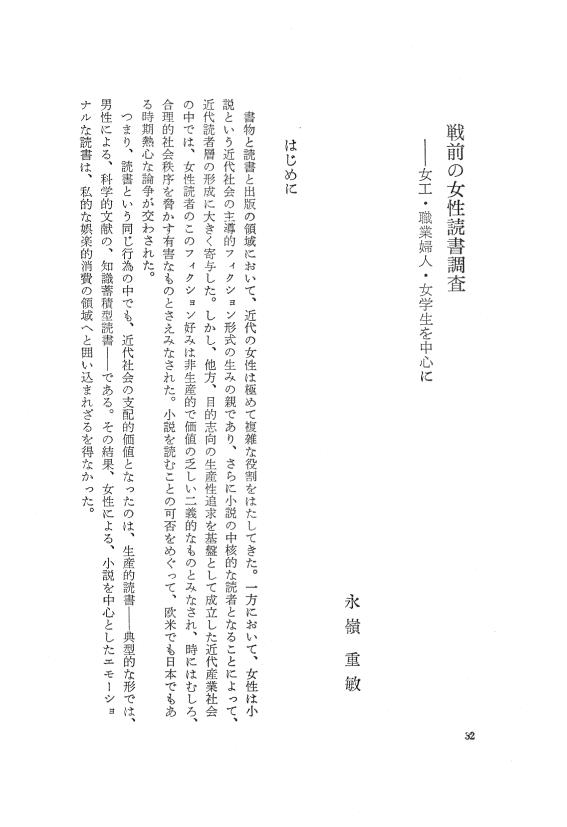- 著者
- 永嶺 重敏
- 出版者
- 日本図書館研究会
- 雑誌
- 図書館界 (ISSN:00409669)
- 巻号頁・発行日
- vol.51, no.4, pp.200-210, 1999-11-01
婦女新聞社や東京日日新聞社をはじめとする新聞社や出版社は,明治から大正にかけて一連の図書館活動を展開するが,この活動はあるユニークな特徴を有していた。それは,通常みられるような直接来館者への閲覧サービスではなく,郵便による非来館者へのサービスを指向していた点である。具体的なサービス活動としては,(1) 郵便による貸出,(2)読書会事業,(3)巡回文庫の3形態が実施されていた。その展開過程をたどり , さらに,サービス対象となった地方読者の視点から,その持つ意味を考察した。
1 0 0 0 OA 大正期東京の「雑誌回読会」問題 ―雑誌のもうひとつの流通経路
- 著者
- 永嶺 重敏
- 出版者
- 日本出版学会
- 雑誌
- 出版研究 (ISSN:03853659)
- 巻号頁・発行日
- vol.29, pp.1-28, 1999-03-20 (Released:2020-03-31)
Zasshi-Kaidokukai was a commercial circulating library of magazines. This sortof library grew rapidly in Taisho Tokyo, and took readers away from magazine sellers. As a result the Tokyo Association of Magazine Sellers decided to forbid the sale of any magazine to the Zasshi-Kaidokukai. Subsequently Zasshi-Kaidokukai filed a lawsuit against the Association.This article deals with this opposition focusing on the system used by Zasshi-Kaidokukai. The system appeared about 1910 in Tokyo, and in 1922 had a membership of about 30,000. It consisted of two divisions. Sales was magazine a circulation library in Tokyo, and the other mail-order of back issues of magazines throughout the country. It played an important role in the circulation of magazines.
1 0 0 0 OA 戦前の女性読書調査 ―女工・職業婦人・女学生を中心に
- 著者
- 永嶺 重敏
- 出版者
- 日本出版学会
- 雑誌
- 出版研究 (ISSN:03853659)
- 巻号頁・発行日
- vol.19, pp.32-69, 1989-04-15 (Released:2020-03-31)
1 0 0 0 OA モダン都市の〈読書階級〉 ―大正末・昭和初期東京のサラリーマン読者
- 著者
- 永嶺 重敏
- 出版者
- 日本出版学会
- 雑誌
- 出版研究 (ISSN:03853659)
- 巻号頁・発行日
- vol.30, pp.41-69, 2000-03-20 (Released:2020-03-31)
- 参考文献数
- 3
In the 1920s, the new middle class which was composed of the teachers, the public servants, the salaried men and the liberal profession, was called also “reading class”. This article deals with salaried men readers and their reading life.First, salaried men were characterized as Sogo-Zasshi (general magazines) readers. Bungei-Shunju and Chuo-Koron were popular among them. Second, the books were symbols as reading class to them. They tended to respect books awfully. Especially they liked Yen-pon (one-yen book). Moreover, they were readers of contemporary popular novels. Authors such as Kan Kikuchi, Ton Satomi, Kido Okamoto, Kaizan Nakazato and Kuni Sasaki were most widely read in them. Reading style of the salaried men has spread over other classes, and as a result, a popularization of reading was realized.
1 0 0 0 黙読の<制度化>--明治の公共空間と音読慣習
- 著者
- 永嶺 重敏
- 出版者
- 日本図書館研究会
- 雑誌
- 図書館界 (ISSN:00409669)
- 巻号頁・発行日
- vol.45, no.4, pp.p352-368, 1993-10
